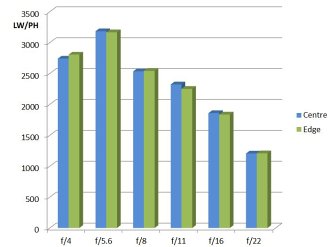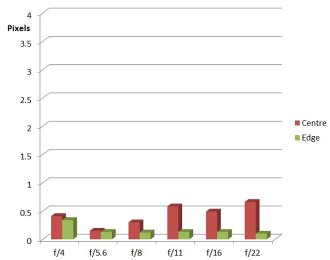Olympus M.Zuiko ED 300mm f/4 IS PRO Review
Olympus M.Zuiko Digital ED 300mm f/4.0 IS PRO Performance
Sharpness is of a very high order. At f/4 the lens is very evenly matched edge and centre and delivers excellent sharpness, bordering on outstanding. At f/5.6 results are truly outstanding right across the frame, with an impressive set of figures that are virtually identical centre and edge. F/8 and f/11 remain excellent and also very even, sharpness only starting to tail off due to diffraction at f/16 and f/22. Used at optimum apertures, results from this Olympus lens are simply superb.
How to read our charts
The blue column represents readings from the centre of the picture frame at the various apertures and the green is from the edges.The scale on the left side is an indication of actual image resolution as LW/PH and is described in detail above. The taller the column, the better the lens performance.
For this review, the lens was tested on an Olympus OM-D E-M5 using Imatest.
CA (Chromatic Aberration) is very well controlled throughout the range, so colour fringing is virtually eliminated.
How to read our charts
Chromatic aberration is the lens' inability to focus on the sensor or film all colours of visible light at the same point. Severe chromatic aberration gives a noticeable fringing or a halo effect around sharp edges within the picture. It can be cured in software.Apochromatic lenses have special lens elements (aspheric, extra-low dispersion etc) to minimize the problem, hence they usually cost more.
For this review, the lens was tested on an Olympus OM-D E-M5 using Imatest.
Looking at the images shot, the bokeh is just lovely and smooth. Such a long lens will by its very nature tend towards selective focus and out of focus backgrounds, and at wide apertures the effect is sublime.
The IS system is remarkably good. Without IS engaged, I could manage a moderately sharp image at 1/160 second, which in itself is not too bad for a 600mm-equivalent lens. With IS switched on, that 1/160 second becomes razor sharp and the difference is very clear to see. A total benefit of six stops is achievable with care, and four stops should be no problem at all. Very impressive.
Distortion is almost non-existent and measures at just -0.193% of barrelling. There are no issues with architectural photography, although this focal length may not be the first choice anyway for such subjects. Flare resistance is likewise excellent.
Value For Money
The Olympus 300mm f/4 IS Pro lens is priced at £2199. This is a large saving compared to the older, larger and heavier Olympus 300mm f/2.8, costing £5689.
Looking at what costs are like for other marques, 300mm f/4 lenses may be less expensive, but if we consider the job they do and look at the crop factors involved, then the picture is quite different.
For example, the Canon 600mm f/4 L IS II USM lens costs £8895, but for crop sensor cameras their 400mm f/5.6 L USM is £889. Nikon users have the AF-S Nikkor 600mm f/4 E FL ED VR (£9650), and Sony users have the Sony 500mm f/4 G SSM (£9,999). The nearest equivalent for Pentax APS-C users would be the SMC Pentax-D FA 150-450mm (£1599) or the SMC Pentax-DA 560mm f/5.6 (£2999). As the new full frame Pentax K-1 becomes available, the 150-450mm is a full frame lens, and Pentax are also listing the 560mm as being fully compatible with the larger format, even though not labelled as such.
Against this backdrop, Olympus MFT users do seem to have here a lens which measures up very well in terms of cost. For more options have a look at the Top 5 Best Olympus Lenses of 2015.
Add your message
Please login here or if you've not registered, you can register here. Registering is safe, quick and free.
photodo Stats
428 MTF tests
74 in-depth photodo reviews
100+ users join each day
Help the lens community by reviewing or rating a lens today via our lens search
Latest Lens Reviews
- Chinon 28mm f/2.8 Vintage Lens Review
- Canon EF 70-200mm f/4L IS II USM Lens Review
- Samyang AF 85mm f/1.4 EF Review
- Sigma 70mm f/2.8 DG Macro Art Review
- Samyang AF 24mm f/2.8 FE Review
- Meike 50mm f/1.7 Review
- Tamron 70-210mm f/4 Di VC USD Review
- Lensbaby Burnside 35mm f/2.8 Review
- Asahi Super Takumar 50mm f/1.4 Review
- Asahi Super-Multi-Coated Takumar 135mm f/3.5 Review


